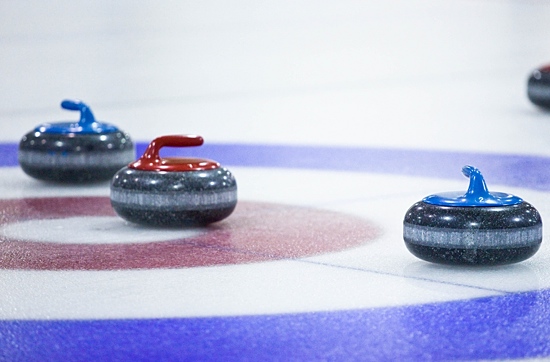Curling group sweeping RVA
A group of “skips” are thrusting n00b curlers from “hacks” into “houses” and then heading to “warm rooms” for some friendly “broomstacking.” Say WHAAAA!?

Curling will be in the spotlight tomorrow when Canada and Great Britain battle for the men’s gold medal in Sochi. One person who’ll be watching is curling fan Scott Walters.
“It’s kind of rare and kind of different,” Walters said about curling. “It’s also a sport where people say, ‘Hey, I can do that!'”
Walters would know. He’s both an amateur curler and president of the Richmond-based Curling Club of Virginia. “It’s a great game to play,” he said about the sport, which dates back to 16th Century Scotland. “It’s something that people of all skills and abilities can do–all ages can do.”
Walters wasn’t lured to the sport until he was 40-years-old. “I like the competition. I like the physical nature of sweeping,” he said. “It takes great balance…[and] aerobic strength.”
Despite those necessary skills–which casual watchers of the sport may not always appreciate–Walters said curling is very egalitarian. “You can play at all levels of skill…that’s the beauty of the sport,” he said. He once curled with the captain of the Scottish National Team. “[People] can’t play hockey with [Alex] Ovechkin,” he said. “But we can go out and curl with world-class players.”
It was a friend that persuaded a reluctant Walters to try curling back when Walters lived in Wisconsin. Walters soon fell in love. “I got excited about it,” he said.
That excitement endured even after he moved to Richmond in 2007, where curling wasn’t nearly as popular as it was in Wisconsin. “There were no curling opportunities in Richmond,” Walter’s said. A minuscule community of local curlers had to drive to Raleigh, NC to play.
But in 2010, a Richmonder got excited about curling during the Vancouver Olympics,1 and created a Facebook group to see if there were other like-minded curling aficionados. There were.
The following year, the casual friendships led to formal meetings to create an official group. By 2012, the Curling Club of Virginia began with roughly 10 original members. “The founding members were made up of some folks like me [who were experienced curlers]…and then it was made up by folks who had never curled before,” Walters said.
The group, now with over 20 members,2 regularly curls at the Richmond Ice Zone in Midlothian.
To play, the club installs hacks on the ice, which players push out from when pushing (or delivering) the stone, which weighs about 42 lbs. “It doesn’t take a big person to [deliver the stones],” Walters said. “It’s all about physics.”
The goal of the game is to deliver the stone as close to the bullseye of three concentric circles, called the house. Each team gets eight stones to deliver, which they can use to reach the center of the house, take out a competing stone, or guard their own stone.
Two sweepers on each team use a broom to reduce friction under the stone (affecting its speed) and increase/decrease the amount of curl each stone has (stones curl most when they slow down). “[Sweeping] allows you to make the stone go farther and a little straighter,” Walters said. He said a good sweeper can make a stone travel 12 – 15 feet farther than the original force of the delivery, and can curl a stone two feet in either direction.
Walters said one of the biggest misconceptions about curling is that it’s shuffleboard on ice. It isn’t. The sweeping and the general aerobic skill of the sport makes it more physically intense than a casual game of cruise-ship shuffleboard.
There’s also the game’s strategy, the intellectual tit for tat between opponents. “It’s a lot like a chess game, where you’re thinking three moves ahead,” Walters said.
Unlike popular sports, there are no referees in curling. If there’s a disagreement, team captains (or skips) confer and work it out. “It’s all about sportsmanship,” Walters said. “There’s no trash talking; no celebrating mistakes of your opponent.”
The Curling Club of Virginia offers several curling classes for beginners. People can choose a 30-minute class ($10) or a 2-hour “Learn 2 Curl” class ($30). The club also offers the Cardinal League, a four-week competition for new curlers ($120).
People can also become a member of the local curling club by paying a $100 annual fee. “It’s a participation sport, and it’s a social activity club,” Walters said. Following each match, players go into the warm room for refreshments, food, and socializing. It’s a traditional post-game event called broomstacking.
Whether on the cold of the ice or in the warmth of fellowship, the Curling Club of Virginia remains Richmond’s gateway to the iconic winter sport. “We’ve had a lot of success with our club,” Walters said. “And we’d love to have people come out and give it a try.”
Correction: An earlier version of this article incorrectly called curling coaches “skiffs.” They are called “skips.”
Related
- What you need to know about Olympic curling at the Sochi Games; SB Nation
- David Attenborough narrates curling; Kottke
- Curling was reinstated as an Olympic sport in 1998 following a 56-year absence. ↩
- A few of whom have joined after attending curling viewing parities during the Sochi Olympics. ↩
photo by Benson Kua
-
Recommend this
on Facebook -

Report an error
-

Subscribe to our
Weekly Digest





Notice: Comments that are not conducive to an interesting and thoughtful conversation may be removed at the editor’s discretion.
Isn’t it “skip” not “skiff?”
Thanks for the information. I want to try curling out!
@Wolf – You’re totally right! I mis-heard the name.
Curling isn’t the only Olympic sport practiced by amateurs in Richmond. Did you know there are two rugby clubs in Richmond, including one over 50 years old? Look for rugby to return to the Olympics in 2016!